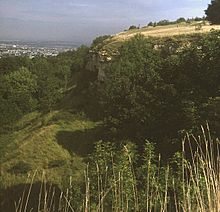Leckhampton Hill and Charlton Kings Common facts for kids
| Site of Special Scientific Interest | |

Cliff face on Leckhampton Hill
|
|
| Area of Search | Gloucestershire |
|---|---|
| Coordinates | 51°52′02″N 2°04′13″W / 51.867306°N 2.070391°W |
| Interest | Biological/Geological |
| Area | 63.8hectare |
| Notification | 1954 |
Leckhampton Hill and Charlton Kings Common is a special place in Gloucestershire, England. It covers about 64 hectares. This area is called a Site of Special Scientific Interest (SSSI). It was given this important title in 1954.
An SSSI is a protected area. It is important for its amazing plants, animals, or rocks. Leckhampton Hill is special because of both its nature and its geology. It is also listed as a Key Wildlife Site. This means it is very important for local wildlife.
Contents
Where is Leckhampton Hill?
This special site is located in the beautiful Cotswolds. The Cotswolds is a famous Area of Outstanding Natural Beauty. Leckhampton Hill is south of the town of Cheltenham. It is close to the villages of Leckhampton and Charlton Kings.
The hill faces north. This means it gets less direct sunlight. The area has natural grasslands. These grasslands grow on Jurassic limestone rock. You can also find old quarry faces here. Quarries are places where rocks were once dug out. There are also piles of rock from the quarries. These piles are now covered in plants.
Amazing Rocks and History
The old quarries at Leckhampton Hill are very important. They show a thick section of Middle Jurassic rocks. These rocks are called the Inferior Oolite strata. Scientists have been studying these rocks for over 150 years.
You can see about 60 meters of rock layers here. These large rock outcrops help scientists learn about the past. They study palaeontology, which is about ancient life like dinosaurs. They also study sedimentology. This is about how rocks are formed from sand and mud. By studying these rocks, we can understand what the Earth was like long ago.
Plants and Animals of the Hill
Leckhampton Hill has many different types of natural areas. These include grassy fields, woodlands, and rocky cliffs. There are also scree slopes, which are piles of loose rocks.
Wonderful Wildflowers
The grasslands here are very important. They have tall grasses like tor-grass and upright brome. Many beautiful wildflowers grow among the grasses. You can find salad burnet and common rock-rose. There is also common bird's-foot-trefoil.
On the old quarry floors, you might spot wild thyme. Other flowers include dwarf thistle and yellow-wort. The rare autumn gentian also grows here.
Some plants at Leckhampton Hill are very rare. These include the fly orchid and musk orchid. You might also see purple milk-vetch. This site is one of the few places in the county where meadow clary grows.
Wildlife Living Here
The bushy areas on the hill are great for birds. Birds like the meadow pipit and grasshopper warbler build their nests here. These bushes also provide shelter for many insects. Small mammals also find a home in these areas.
The wooded parts of the hill have different trees. There are broad-leaved trees and conifer trees. You can find old beech trees. These woodlands have their own special plants. Some examples are ivy broomrape and white helleborine. The beautiful greater butterfly-orchid also grows in the woods.
There are also reports of adders living on the hill. Adders are a type of snake.

